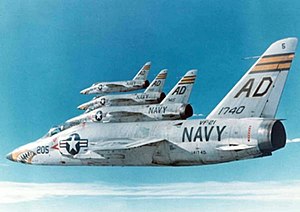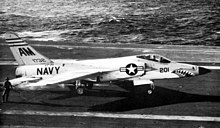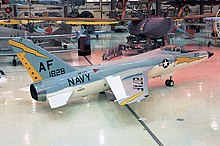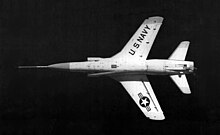Grumman F11F
| Grumman F11F / F-11 Tiger | |
|---|---|
 Grumman F11F-1 "Tiger", VF-21 "Mach Busters", 1959 |
|
| Type: | Fighter plane |
| Design country: | |
| Manufacturer: | |
| First flight: |
July 30, 1954 |
| Commissioning: |
1956 |
| Production time: |
1954 to 1959 |
| Number of pieces: |
199 |
The F11F Tiger (from 1962 F-11 Tiger ) from Grumman was a single-seat aircraft carrier-based fighter that the United States Navy used in the 1950s and 1960s.
development
In 1952, Grumman began planning a further development of the Grumman F9F Cougar . The ability to fly supersonic should be achieved by applying the area rule . In addition, slats were installed over the entire length of the wings and spoilers instead of ailerons on the trailing edge of the wing . For storage on aircraft carriers, the wings could be folded up halfway to save space. The Wright J65 turbojet engine was used as the engine . The Navy Bureau of Aeronautics commissioned two prototypes, designated the XF9F-8 , and later the XF9F-9 . The first model flew for the first time on July 30, 1954, still without an afterburner . The second model later reached the speed of sound with an afterburner - the second Navy aircraft after the Douglas F4D Skyray . In April the Tiger was given the designation F11F-1 .
In 1958 Grumman converted two F11F- 1s into so-called F11F-2s (serial numbers "BuNo" 138646-138647). These received a slightly larger tail unit, enlarged air intakes and the General Electric J79 engine . The first flight of this model took place on May 25, 1958; the Super Tiger reached speeds of Mach 1.44. After further changes, including a modified engine version , the F11F-2 reached twice the supersonic speed. However, since the aircraft was too heavy for carrier use, the prototypes were renamed F11F-1F and no further orders were awarded. In the meantime, the German Air Force , the Air Force of the Japanese Self-Defense Forces and the Royal Canadian Air Force were interested in the model, but ultimately procured the Lockheed F-104 Starfighter .
Mission history
The first Tiger landed on the USS Forrestal (CVA-59) on April 4, 1956 and then completed the first catapult launch. In 1961, however , the Tiger was taken out of service again because the engine proved to be unreliable and the Vought F-8 Crusader proved to be superior in terms of performance. 199 F11F- 1s had been built by then (BuNo 138604-138645, 141728-141884). A reconnaissance variant F11F-1P was deleted again.
Relay service
On May 8, 1957, the newly established VA-156 "Iron Tigers" squadron was equipped with the F11F-1 Tiger "short nose". It is unusual for an Attack Squadron (VA) to receive a fighter plane, as fighters were usually given to VF squadrons. The second season was the Jagdstaffel VF-21 "Mach Busters"; they qualified their pilots for the carrier mission on the aircraft carriers Forrestal , Bennington and on the Ranger , but did not fly out of carriers for use. The VF-33, VF-51, VF-121, VF-191 and VF-211 squadrons were also equipped with the F11F-1 "long nose". The VA-156 squadron was renamed VF-111 in 1958.
The period of service of the Tigers in the US Navy carrier squadrons did not last long, as early as 1961 most of these squadrons gave up their machines and switched to the F8U-1 Crusader . The Tiger was now used in the training relay teams and the Blue Angels aerobatic team. In 1957 the Blue Angels were equipped with the "short nose" and switched to the "long nose" after the 1958 season. The Tiger was very popular with the Blue Angels because of its maneuverability and ease of use. The F8U-1 Crusader was also evaluated as a successor by the Blue Angels , but was rejected as completely unsuitable. It was not until 1969 that the Tiger was replaced by the F-4J Phantom II from McDonnell-Douglas . The Phantom was like the Crusader not suitable for aerobatics, the ever-increasing problems of logistics and spare parts of the Tiger forced the US Navy, however, to take this step.
Trivia
Although the tigers were never used in a war - not even during the Lebanon crisis of 1958 - they were shot down anyway. The F-11 Tiger is arguably the first aircraft that shot itself down.
On September 21, 1956, test pilot Tom Attridge from the Grumman Aerospace Company flew a test mission with a Tiger at an altitude of about 6,800 meters east of Long Island , during which the weapon system was to be checked for proper function. To test the cannons, he fired the four 20 mm cannons with a burst of four seconds. Then he went into a descent and with a second burst of three seconds fired the remaining ammunition of the cannons. After firing, Attridge went to Mach 1.3 and continued the descent. Something hit the windshield at an altitude of 2,100 meters; at the same time, the engine lost around 80% of its power. Attridge managed to climb back to 4,000 meters in the wrecked aircraft, but in the process he gradually lost speed. He now flew cautiously towards Long Island, where preparations for an emergency landing at the works airfield began. Attridge was falling and losing speed; shortly before Long Island the engine finally failed. He reached Long Island while gliding. However, he did not reach the airfield; the plane crashed into a group of trees. Attridge was hospitalized with injuries.
The commission of inquiry formed after the crash found that Attridge had thwarted the ballistic curve of the 20mm rounds he had fired. The plane had three hits; a projectile had hit the air intake duct, parts of which destroyed the engine.
Data
| Parameter | Data |
|---|---|
| span | 9.6 m |
| Wing area | 23 m² |
| length | 14.3 m |
| height | 4.0 m |
| Empty weight | 6,277 kg |
| Max. Takeoff weight | 9,561 kg |
| Engine | 1 × Turbojet engine Wright J65-W-18 |
| Top speed | 1,170 km / h |
| Summit height | 12,800 m |
| Rate of climb | 83 m / s |
| Range | 2,050 km |
| Armament | 4 × 20 mm Colt Mk 12 cannon with 125 rounds each, 4 × AIM-9 Sidewinder |
Web links
Individual evidence
- ↑ Grumman F11F Tiger. aviastar.org, accessed February 22, 2013 .
- ↑ F11F (F-11) Tiger. Flugzeuginfo.net, December 30, 2012, accessed February 22, 2013 .
- ↑ a b Encyclopedia of Aircraft , Aerospace Publishing Ltd., 1992, p. 149
- ↑ Grumman F11 A / 1 Tiger. (No longer available online.) Yanksair.com, archived from the original on September 21, 2015 ; Retrieved February 22, 2013 . Info: The archive link was inserted automatically and has not yet been checked. Please check the original and archive link according to the instructions and then remove this notice.
- ↑ Grumman F11F "Tiger". (No longer available online.) Aer.ita.br, formerly in the original ; Retrieved February 22, 2013 . ( Page no longer available , search in web archives ) Info: The link was automatically marked as defective. Please check the link according to the instructions and then remove this notice.
- ↑ a b Grumman F11F-1 / F-11A Tiger. joebaugher.com, January 30, 2000, accessed February 22, 2013 .
- ↑ Grumman F11F-1 Tiger Blue Angel. combatairmuseum.org, accessed February 22, 2013 .
- ↑ a b A Tiger Bites Its Tail. aerofiles.com, accessed February 22, 2013 .
- ↑ To Unlucky First ... The Shootdown of Tiger # 620. check-six.com, accessed February 22, 2013 .
- ↑ Grumman F11F-1 Tiger. wings-aviation.ch, February 2, 2009, accessed on February 22, 2013 .





